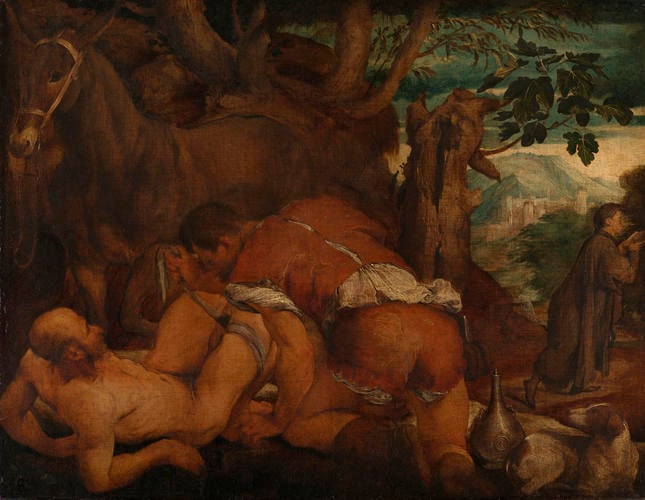The Good Samaritan c. 1545-50
Oil on canvas | 64.8 x 84.2 cm (support, canvas/panel/stretcher external) | RCIN 405771
-
The parable of the Good Samaritan is told by Jesus in the Gospel of Luke (10:29-37). A traveller is stripped of his clothes, beaten, robbed, and left half dead. A priest and then a Levite come by, but both ‘pass by on the other side’; finally the man is saved by a Samaritan, who pours oil and wine onto his wounds and bandages them. Here the victim is lying naked at the left of the composition. His leg is being bandaged by the Samaritan, who is kneeling, wearing brown shorts and a jerkin over a white shirt, with his back to the viewer. The mule included behind them relates to the next stage in the parable, when the Samaritan put the injured man on his own donkey and brought him to an inn to take care of him. To the right the Levite walks away down a path, reading his book; the tiny white figure disappearing into the landscape behind the mound may be the priest. The painting is very well preserved with unusually little repainting. It is thinly painted and several pentimenti are visible; the Samaritan’s hand with its bandage was painted over the completed thigh of the nude and the mule’s foreleg, and the small white figure of the priest was added after the landscape was painted. The figure of the Samaritan is based on the same drawing which served (in the same direction) for the kneeling shepherd in the ‘Adoration of the Shepherds’ (RC405772), and (in reverse) for shepherds in the ‘Adoration of the Kings’ (National Gallery of Scotland, Edinburgh). The town visible in the background is Bassano, with Monte Grappa behind it. There is a closely related painting in the Capitoline Museum, Rome, and other versions of the subject by Bassano are in Prague and the National Gallery, London.
Provenance
Belonged to Charles I (whose brand appears on the reverse); sold for £22 from Hampton Court to Turbridge on 30 April 1650 (no 302); recovered at the Restoration and listed in the Passage between the Green Room and Closet at Whitehall in 1666 (no 303)
-
Creator(s)
-
Medium and techniques
Oil on canvas
Measurements
64.8 x 84.2 cm (support, canvas/panel/stretcher external)
86.3 x 105.0 x 6.4 cm (frame, external)








